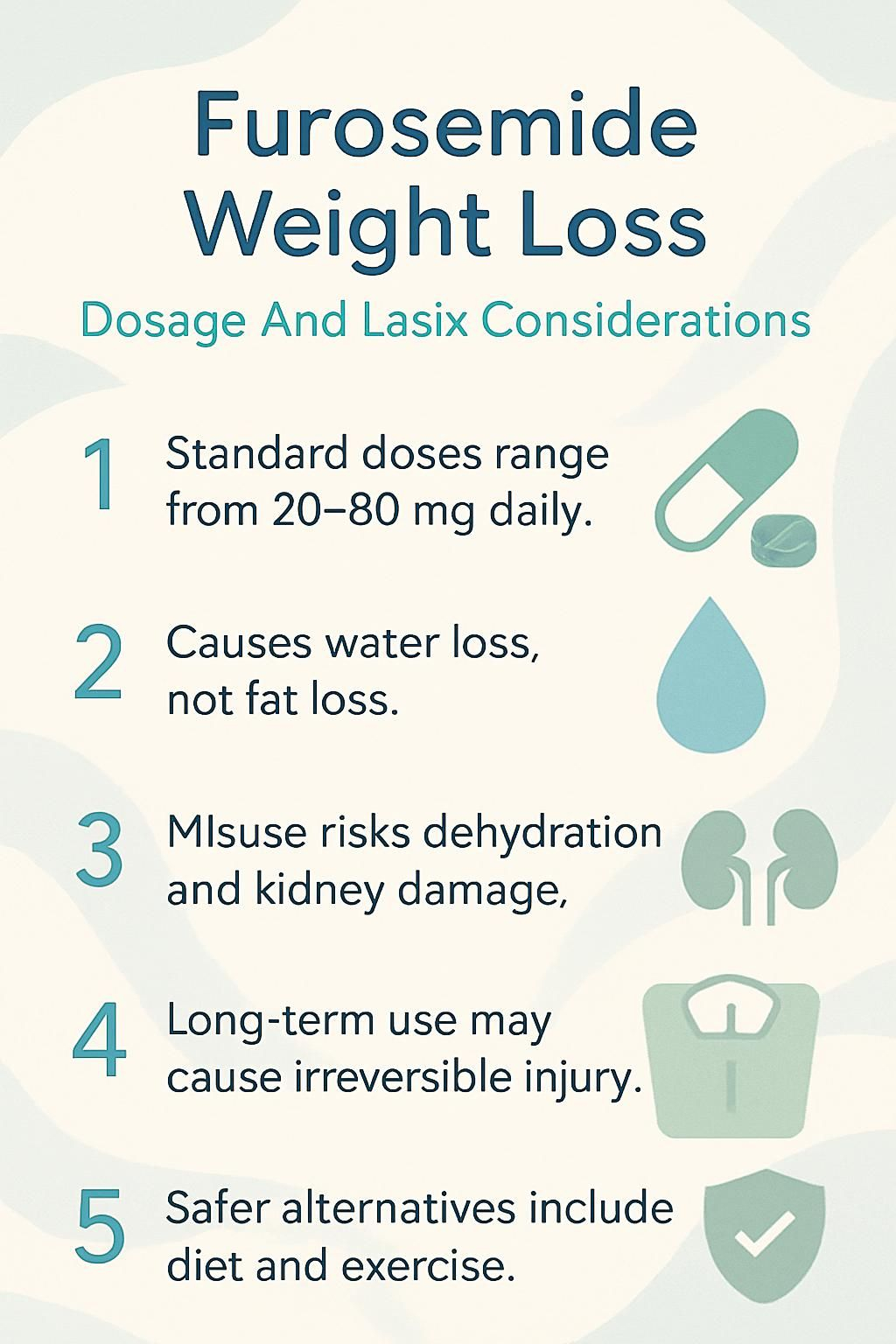Furosemide Weight Loss: Dosage And Lasix Considerations
Our Nutrition Assistant AI Suite will transform your body. You will lose fat, get toned, and build muscle. Gain confidence and optimal health.
Searching for furosemide weight loss tips often means you want fast results. Furosemide, also called Lasix, is a prescription diuretic, a water pill, for health problems like heart failure, edema, and high blood pressure. Some people still try it to drop pounds quickly.
This guide explains what furosemide is, how it works, the real risks, proper dosage guidance, and safer options. If you have questions about furosemide, its effect on your body, and possible side effects, keep reading for clear answers.
Key Takeaways
- Furosemide, Lasix, pulls off water weight, not body fat. It is approved for medical conditions like heart failure, edema, and hypertension, not for weight control.
- Typical adult doses are 20 mg to 80 mg daily. Misuse for weight loss can cause dehydration, kidney injury, low potassium, and dangerous heart rhythms.
- Using furosemide without a prescription or mixing it with other medicines like NSAIDs or antihypertensives raises the risk of serious drug interactions and adverse effects.
- Long-term misuse can lead to chronic dehydration, lasting electrolyte problems, rebound weight gain, and possible heart or kidney damage.
- Clinicians recommend safe alternatives, such as a calorie-controlled eating plan and regular exercise, for healthy long-term weight management.

What is Furosemide and How Does It Work?

Furosemide is a strong diuretic. A diuretic is a medicine that helps your kidneys remove extra salt and water through urine. It can lower your blood pressure and reduce swelling caused by fluid buildup.
How Does Furosemide Affect the Body?
Furosemide oral tablets increase urine output by pushing your kidneys to release more sodium and water. That rapid fluid loss can drop your scale number for a short time.
Doctors call this effect diuresis. It usually starts within one hour for furosemide oral doses and even faster with intravenous therapy.
The extra urine helps treat edema from heart failure, kidney disease, or cirrhosis. Blood pressure can fall because there is less fluid in your blood vessels.
The starting dose of furosemide often ranges from 20 mg to 80 mg per day in adults, based on your condition and response.
“Furosemide helps reduce swelling and improve breathing by making you lose extra salt and water through urine.”
What Is the Mechanism Behind Furosemide?
Furosemide acts on part of the kidney called the loop of Henle. It blocks the reabsorption of sodium and chloride there. Your body then flushes out more salt and water in your urine, which lowers fluid buildup and swelling.
This action can also lower potassium and calcium levels, which raises the risk of electrolyte imbalance. That is one reason doctors monitor lab results during treatment.
Furosemide is a loop diuretic commonly used for heart failure, hypertension, and nephrotic syndrome. High doses, such as 6 mg per kg of body weight, can cause marked water loss.
You may see quick weight changes as water leaves the body. This is temporary. Understanding how furosemide moves fluid explains why it helps treat edema and high blood pressure, not body fat.
Approved Uses of Furosemide
Doctors prescribe furosemide to manage health problems linked to extra fluid. These include swelling, high blood pressure, and heart failure.
How Does Furosemide Treat Edema?
Furosemide helps your kidneys remove excess fluid from your blood and tissues. Less fluid means less swelling. This is vital for congestive heart failure, where fluid can pool in the legs or lungs.
The medicine works quickly. Many people notice more frequent urination within an hour of a dose, followed by reduced swelling.
You might find your shoes or rings fit better. A patient once told me, “After my first dose, I used the restroom many times, and my ankles looked normal the next morning.” Your clinician may adjust the dose based on your response and kidney function.
Can Furosemide Help Manage High Blood Pressure?
Furosemide can lower your blood pressure by removing fluid and sodium through urine. Less volume in your bloodstream helps your heart pump with less strain.
Thiazide diuretics are often tried first for hypertension. Furosemide is used if you have kidney disease, heart failure, or need fast results in a clinical setting.
As a nurse on a cardiac unit, I often gave Lasix to patients with acute decompensated heart failure and very high blood pressure, such as 180 over 110 mmHg.
Your doctor will choose the route of administration and adjust your dose after an assessment of kidney function and response. Common side effects include low potassium and dehydration if doses are high or if fluid intake is poor. Combining furosemide with medicines like spironolactone or eplerenone may require close monitoring.
What Role Does Furosemide Play in Heart Failure?
In congestive heart failure, furosemide pulls off fluid fast to ease swelling and improve breathing. Relief can come within hours.
A specific dose of furosemide may reduce stress on the heart and help prevent complications like stroke or worsening kidney function. Better control of blood pressure supports overall heart health.
Many people notice less ankle swelling and can walk further with less shortness of breath. If you develop sudden weight gain, worse swelling, or breathing trouble while taking furosemide, contact your care team. Your dose may not be enough.
Follow the prescribed dosage to get the benefits and limit risks such as dehydration and electrolyte imbalance. In certain cases, furosemide can increase plasma protein binding, which clinicians track during treatment.
Using Furosemide for Weight Loss: What You Should Know
Some people take furosemide, Lasix, to shed a few pounds before an event. High doses raise the chance of side effects and serious health problems.
How Does Furosemide Cause Temporary Water Weight Loss?
Furosemide pushes your kidneys to release sodium and water. Water makes up about 60 percent of your body weight, so the scale can drop quickly.
The brand-name drug Lasix may change your weight fast, but the loss is water, not fat or muscle. Most people see the weight return once they rehydrate or stop the medicine.
During a hospital stay, I lost three pounds in a day after receiving furosemide for swelling. That weight returned once my fluid balance normalized.
Next, see why this medicine is a poor plan for long-term weight control.
Why Is Furosemide Not Suitable for Long-Term Weight Loss?
You may drop water weight quickly with a diuretic, then regain it when you drink fluids. Furosemide does not remove body fat or treat obesity.
Studies and expert guidance show lasting weight management needs steady lifestyle changes. A pill that causes dehydration does not fix the problem.
I once tried a water pill to jump-start a diet. The weight bounced back in days. Doctors use furosemide to treat medical conditions like edema and high blood pressure, not as a fat loss plan.
Now learn about the major health risks tied to using furosemide for weight loss.
What Are the Health Risks of Using Furosemide for Weight Loss?
Off-label use for weight loss can create serious medical problems. These risks often need urgent care.
How Does Furosemide Cause Dehydration?
Furosemide acts on the ascending limb of the loop of Henle in your kidneys. It blocks sodium and chloride from being taken back into the blood. More salt in the urine pulls out more water.
If you do not drink enough fluids, your body cannot keep up. Signs include thirst, headaches, dry mouth, and fatigue.
Severe dehydration can lead to dizziness and low blood pressure. This risk grows when people use furosemide off-label for quick weight loss. Next, see how electrolyte levels can swing out of range.
What Are the Risks of Electrolyte Imbalance?
High doses or unsupervised use can upset sodium, potassium, and magnesium levels. Hyponatremia, low sodium, can cause confusion, seizures, or extreme tiredness. Hypokalemia, low potassium, can trigger muscle cramps, weakness, or dangerous heart rhythm problems.
Rarely, high potassium, hyperkalemia, can develop and threaten the heart as well. Warning signs include cramping, dizziness, and confusion. Untreated problems can require emergency care.
Blood sugar level changes may also occur during treatment for high blood pressure or edema. Routine lab checks help catch these issues early.
Can Furosemide Damage Your Kidneys?
Overuse can harm the kidneys, especially with high doses taken for long periods. Chronic dehydration increases the chance of permanent kidney damage or kidney failure.
People with kidney disease need close monitoring of glomerular filtration rate to prevent further harm. Electrolyte problems can add extra stress to the kidneys.
If you live with diabetes or heart disease, your doctor will likely check kidney function often. Swelling, changes in urination, or sudden weight gain while taking furosemide signal that you need a review of your dose.
Next: learn about heart risks linked to furosemide misuse.
What Heart Problems Can Furosemide Cause?
Furosemide can trigger heart rhythm problems when electrolytes, especially potassium and magnesium, drop too low. Irregular heartbeats can be life-threatening if not treated quickly.
People with heart disease face higher risk of complications such as myocardial infarction. Low blood pressure can also occur, making it hard for your body to circulate blood well.
Close monitoring is vital if you have cardiovascular disease or take drugs that may interact with furosemide, such as NSAIDs or other blood pressure medicines. Report chest pain, palpitations, or dizziness right away so your doctor can adjust your dose.
What Are the Dosage Guidelines for Furosemide?
Clinicians select the dosage based on your condition and response to treatment. Higher doses can increase both benefit and risk, so take it exactly as prescribed.
What Are the Standard Doses for Medical Conditions?
Furosemide oral tablet strengths include 20 mg, 40 mg, and 80 mg. Your dose depends on the approved indication and your health needs.
Liquid forms are available if you have trouble swallowing tablets. In hospitals, nurses may give injectable furosemide for severe edema or rapid fluid removal under strict pharmacovigilance.
For adults with edema, a common starting dose is 20 mg to 80 mg once daily. Management of hypertension often begins lower, then adjusts over time.
Children receive weight-based dosing that considers the medical problem. Dose changes depend on kidney function, presence of ascites, or heart failure. Clinicians use guidelines that balance bioavailability with safety.
Following medical advice closely reduces the risk of mistakes or overdose.
Why Is Following Medical Advice Important?
Standard doses provide a starting point, but your doctor customizes your plan. Only a healthcare professional can decide if furosemide is safe for you or if a different diuretic such as torasemide or indapamide makes more sense.
Sticking to the prescribed dose lowers the chance of dehydration, electrolyte imbalance, kidney injury, and hearing loss. Skipping visits or self-medicating invites trouble.
Too much furosemide can cause low potassium and low blood pressure. Monitoring and dose adjustments help you stay safe. Careful changes and drug checks helped me avoid an admission after I developed gout on furosemide. Always talk with your doctor before changing your dose or stopping the drug.
How Is Furosemide Misused and What Are the Consequences?
People sometimes misuse this tablet for fast weight loss. Misuse can lead to serious side effects and health risks.
What Are Examples of Furosemide Misuse for Weight Loss?
- Some athletes take high doses before weigh-ins for sports like wrestling or boxing. This can cause rapid dehydration and major electrolyte loss.
- People with disordered eating may use tablets without medical care, risking very low potassium and other imbalances.
- Some obtain furosemide illegally or through over-the-counter channels to look slimmer for events, skipping key safety checks.
- Users sometimes mix furosemide with substances like semaglutide or tirzepatide, which can cause mild or serious side effects.
- Online posts can spread misleading advice about using diuretics for appearance changes after COVID-19 lockdowns.
- As a pharmacy technician, I saw people avoid reporting adverse effects or skip checking for drug interactions, which raised their risk.
- Mixing alcohol while taking furosemide increases dehydration and the chance of low blood pressure or heart issues.
- Some take higher-than-prescribed doses hoping to force more urination or bowel movements, which strains the kidneys.
- Others double doses after a missed dose, thinking it will speed weight loss. It increases overdose risk.
- A few with heart conditions self-treat to manage swelling or weight changes without cardiology input, risking severe complications.
What Are the Long-Term Effects of Misusing Furosemide?
Long-term misuse often leads to chronic dehydration. Electrolyte problems like low potassium or sodium can cause weakness, confusion, or seizures.
Repeated high dosing can harm the kidneys. Rebound weight gain is common once you stop the drug because water returns.
Some patients develop lasting heart rhythm issues because low potassium stresses the heart. If you are taking furosemide for high blood pressure and start misusing it for weight loss, the chance of long-term harm increases.
What Are the Common Side Effects of Furosemide?
Furosemide can cause side effects that disrupt daily life. Report side effects to your healthcare provider and avoid self-medicating.
Why Do Nausea and Dizziness Occur?
Fast shifts in fluid and electrolytes can upset your stomach. You lose water, sodium, and potassium as urination increases, which can trigger nausea.
Frequent urination can also lower blood pressure and make you feel lightheaded or dizzy. Headaches may follow. A low sodium diet or poor hydration increases these risks.
People with migraine or those recovering from bariatric surgery may be more sensitive. Doubling a dose after a missed dose often makes nausea and dizziness worse. Report persistent symptoms to your provider.
Can Furosemide Cause Blurred Vision or Hearing Issues?
Blurred vision can occur, especially when starting or increasing the dose. Severe eye symptoms in those who are allergic to furosemide need urgent care.
Hearing problems are a serious concern. Furosemide can cause ototoxicity, damage to the ear, which presents as ringing or partial hearing loss. The risk is higher with large doses or rapid IV use.
I helped a family member track hearing after starting furosemide for heart failure. Frequent check-ins caught mild changes early and prevented larger problems. Report new vision or hearing changes right away.
What Serious Side Effects Should You Watch for With Furosemide?
Some side effects require immediate medical care. Know the warning signs so you can act fast.
How Can Furosemide Cause Low Blood Pressure?
By removing sodium and water, furosemide reduces blood volume and can drop your blood pressure. Dizziness, fainting, or weakness can occur, especially when standing quickly.
Older adults and people with heart disease need close monitoring. In my practice, I have seen patients feel weak only hours after a dose, showing how fast furosemide may lower blood pressure.
What Is Hypokalemia and Why Is It Risky?
Hypokalemia means low potassium in your blood. Potassium helps muscles and the heart work correctly. Furosemide and similar diuretics like bumetanide can remove too much potassium through urine.
When potassium drops below 3.5 mmol/L, you may notice muscle weakness, constipation, or irregular heartbeats. In severe cases, the heart may not pump effectively. Regular blood tests help track potassium levels.
People with heart failure or those using drugs like botulinum toxin or galcanezumab may feel stronger effects. Skipping medical guidance or self-paying for furosemide without a plan puts you at risk. Follow dosing instructions and watch for warning signs.
How Does Furosemide Interact with Other Medications?
Furosemide can interact with many drugs, including over-the-counter products and supplements. Tell your doctor about everything you take.
What Happens When Furosemide Is Taken with Blood Pressure Drugs?
Taking furosemide with ACE inhibitors or ARBs can push your blood pressure lower than expected. These drugs either remove fluid or relax blood vessels. Very low blood pressure can make you feel dizzy or weak.
Using several antihypertensives at once raises the risk of hypotension. Doctors often monitor blood pressure and kidney function more closely in this situation.
Your kidneys may need extra care if you combine medicines for high blood pressure. The risk for dehydration and electrolyte imbalance increases, especially with heat or exercise. A friend once felt faint after both medicines on a hot day, which showed the need for careful monitoring.
Can Furosemide Conflict with NSAIDs or Other Substances?
NSAIDs like indomethacin can reduce the diuretic effect of furosemide by changing blood flow in the kidneys. That can make furosemide less effective for edema or high blood pressure.
Sucralfate, phenytoin, methotrexate, and cephalosporins may also interact. These substances can alter absorption or removal of furosemide, raising side effect risk.
Mixing drugs without guidance is risky. If you take furosemide with other medicines, your provider may need to change the dose or increase monitoring.
When Should You Avoid Using Furosemide?
Do not use furosemide if you are allergic to it. Some health problems require special caution or a different drug.
What Health Conditions Prevent Safe Furosemide Use?
Kidney, liver, or heart problems can raise the chance of side effects. A history of arrhythmias or low potassium can worsen on furosemide.
People with diabetes may see changes in blood sugar. Those with gout can have flare-ups because furosemide affects uric acid levels. Lupus symptoms can worsen and need close monitoring.
Prostate or urinary tract problems can make passing urine difficult after taking a diuretic that acts on the ascending limb of the loop of Henle. Some individuals are allergic to furosemide itself. Share all drug allergies with your provider before starting.
Is Furosemide Safe During Pregnancy or Breastfeeding?
Safety during pregnancy or breastfeeding is not fully known. Use furosemide only if your doctor decides the benefits outweigh the risks.
If prescribed, you and your baby may need close monitoring for dehydration or changes in milk supply. Follow dosing and timing instructions carefully and report possible side effects.
The next section covers safer, proven strategies for weight control during these life stages.
What Are Safer Alternatives for Weight Loss?
Many people look at the cost of furosemide as a quick solution. Safer methods can deliver results that last without the medical risks.
How Can Nutrition Plans Support Weight Loss?
A balanced, calorie-controlled eating plan can support steady fat loss. Include fruits and vegetables with mild natural diuretic effects, such as watermelon, pineapple, asparagus, and watercress, to support fluid balance.
Whole grains, lean proteins, and healthy fats keep you full and fueled. Limiting processed foods and salt reduces water retention.
People who use structured meal plans tend to lose more weight and keep it off longer than those who chase quick fixes. Choosing a nutrition plan also helps you avoid dehydration, electrolyte imbalance, and kidney problems linked to water pills.
What Are the Benefits of Regular Exercise?
Exercise improves blood flow and can reduce mild fluid retention through sweating. Activity also burns calories, which helps reduce body fat over time.
Simple options work well. Brisk walking or swimming several times per week improves heart health and supports weight control without the risks tied to diuretics.
Consistent movement strengthens muscles and boosts mood. Active people often maintain a healthier weight than those who are inactive.
Why Should You Consult a Healthcare Professional for Weight Management?
A healthcare professional can spot hidden issues that slow progress, such as thyroid or hormone problems. You also get a personalized plan that fits your life and health history.
Your provider can track lab results and symptoms to reduce the risk of dehydration, electrolyte imbalance, and heart problems. With expert guidance, I learned my blood pressure was high and focused on food choices and activity instead of Lasix for simple weight control.
What Should Furosemide Users Keep in Mind?
Take furosemide as prescribed and keep follow-up appointments. Good habits reduce risk and improve results.
Why Is Monitoring Electrolytes Important?
Furosemide can lower sodium, potassium, calcium, chloride, and magnesium. Changes in these minerals can trigger irregular heartbeats, muscle weakness, or other serious problems.
Regular blood tests help you find issues early. Monitoring is even more important if you use higher doses or long-term therapy.
You might not feel low electrolytes right away. My provider checked my labs after a week on furosemide and found my potassium was low before I had symptoms.
How Much Hydration Is Needed While Using Furosemide?
Hydration and electrolyte monitoring go together. Furosemide increases urination, which raises the risk of dehydration if you do not drink enough.
Watch for dry mouth, thirst, or dizziness. Your doctor will set a hydration plan that fits your health and daily activity. Do not change fluid intake without guidance. Too much or too little water can both be harmful.
If you notice signs of excessive fluid loss while using furosemide for weight loss or edema, contact your provider to review your dose and hydration plan.
What Are the Recommendations on Alcohol and Diet?
Your provider may ask you to limit or avoid alcohol while on furosemide. Alcohol can worsen dehydration and cause dizziness or low blood pressure.
Eat foods rich in potassium to help prevent low levels. Bananas, oranges, spinach, and potatoes are good choices. Lower salt intake to reduce water retention. People with heart failure may need more specific dietary directions.
Frequently asked questions about Furosemide and weight loss
These brief answers can help you set safe expectations and plan your next steps.
Can Furosemide Lead to Long-Term Weight Loss?
Weight change from furosemide is from water loss, not fat loss. The number on the scale may drop, but it is temporary. Hydration brings the weight back.
Lasix does not target body fat. Research shows that diuretics like furosemide do not support long-term weight loss. As a nurse, I saw patients lose a few pounds after a dose for medical reasons, then regain it the next day after drinking fluids.
Use furosemide only for approved conditions such as heart failure, edema, or high blood pressure under medical care. For weight control, rely on nutrition plans and regular exercise.
How Quickly Does Furosemide Start Working?
Furosemide works fast for water loss. Oral doses often increase urine output within about one hour. Intravenous doses can work in as little as five minutes.
The peak effect usually occurs in the first few hours. This speed explains why some misuse it for quick weight changes, even though the change is only water. Always use furosemide with medical supervision due to risks like dehydration and electrolyte imbalance.
Medical Disclaimer
Always seek guidance from a licensed professional before using furosemide for weight loss or related conditions. Proper oversight helps prevent avoidable harm.
Why Is Professional Medical Guidance Crucial?
Only trained professionals can decide if furosemide is appropriate and safe for your situation. Your doctor reviews your health, current medicines, and risks before prescribing.
Possible side effects include dehydration, electrolyte imbalance, and kidney damage. Medical supervision allows for lab monitoring and dose adjustments to protect your heart and kidneys.
In a clinic where I worked, people who self-medicated with furosemide developed severe low potassium, dizziness, and risky blood pressure swings. Careful follow-up helped prevent repeat events.
What Are the Dangers of Self-Medication?
Self-medicating with furosemide can be dangerous. Without medical guidance, many people miss early warning signs such as low potassium, kidney problems, or heart rhythm changes.
You also miss key lab checks for sodium and potassium. A neighbor tried to lose weight with furosemide and ended up in the emergency department with severe cramps and dizziness.
If an overdose occurs, call 911 or Poison Control at 800-222-1222 right away. Rely on your doctor for dosing and monitoring to avoid life-threatening issues, especially if other drugs are involved.
Conclusion
Furosemide, Lasix, may look like a shortcut for weight loss, but it carries real danger. This medicine removes water, not fat. Using furosemide without a medical reason can lead to dehydration, low blood pressure, and serious electrolyte problems.
Misuse can harm your kidneys or heart. The safe path is steady, supported change through nutrition and exercise, plus medical care when needed. Use furosemide only as prescribed and watch for side effects. Your health comes first.
Sources: FDA Prescribing Information for furosemide; American Heart Association guidance on hypertension; National Kidney Foundation resources on diuretics and kidney health.
FAQs
1. What is the recommended dosage for furosemide when used for weight loss, and what should patients consider before starting Lasix?
Doctors usually prescribe furosemide based on individual health needs. The typical starting dose for adults is 20 to 80 milligrams per day, taken as a single dose or divided into two doses. Patients must consult their healthcare provider before using Lasix for weight loss because it is not approved for this purpose. Medical supervision helps prevent misuse and monitors for side effects.
2. What are all possible side effects of taking furosemide (Lasix) for weight loss?
Furosemide can cause many side effects. Common ones include dehydration, low blood pressure, dizziness, muscle cramps, increased urination, and electrolyte imbalances such as low potassium or sodium levels. Serious side effects may involve kidney problems, hearing changes, irregular heartbeat, rash, or allergic reactions. Reporting any side effect to a doctor is important.
3. Is furosemide (Lasix) safe for long-term use in weight management?
Furosemide is not safe for long-term use in weight management. It removes water from the body but does not reduce body fat. Prolonged use can lead to severe electrolyte disturbances, kidney damage, or heart issues. Medical guidelines do not support its use for routine weight control.
4. Can personal experiences with furosemide help others understand the risks of using it for weight loss?
Personal stories often highlight risks that clinical data also show. For example, one patient used furosemide without medical advice and experienced muscle weakness along with dizziness due to low potassium levels. This case shows why it is vital to include all possible side effects when considering any medication for off-label uses like weight loss.
Summary: Furosemide (Lasix) has specific dosage guidelines set by doctors; it carries many possible side effects that require careful monitoring; it is unsafe for long-term weight control; personal experiences confirm the importance of medical supervision due to potential risks.







